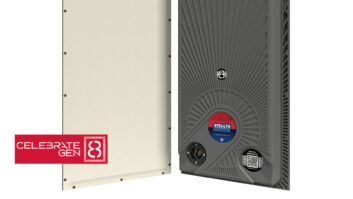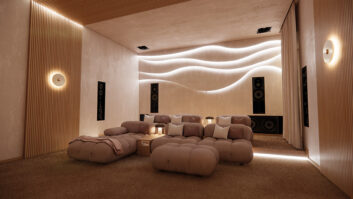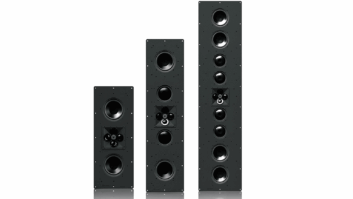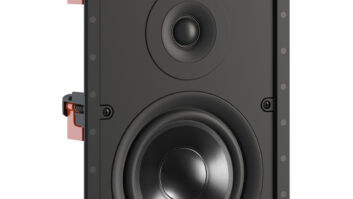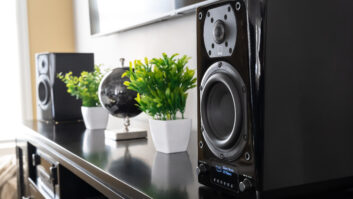For manufacturers of in-wall and in-ceiling architectural speakers, aesthetic details as essential as ever, but many of the major players in the category also have begun turning their attention toward audio performance in an attempt to improve bass output and the overall musicality of their offerings. These improvements provide a new story for dealers to tell clients and a way for veteran integrators to stand out against lesser competitors.

Paradigm offers a more rigid chassis and mounting brackets that, unlike typical mounting ears, cover the full diameter (or height) of the speaker. “For quite a while, even the most upscale performance-oriented dealers were forgetting about their performance roots when it came to architectural speakers,” noted Sandy Gross, co founder of GoldenEar Technology. “Now the situation seems to be changing as they realize that offering real high-performance speakers is another arrow in their quiver when competing against trunk slammers and security companies doing installs, and a tremendous benefit for their customers.”
Gross’ company approaches the design of its in-wall and in-ceiling speakers as though it were designing freestanding audiophile speakers. “In particular, all of our Invisa Series architectural speakers incorporate the same technology high velocity folded ribbon tweeters as all our speakers do, along with complex linear phase crossovers,” he said. “In terms of value proposition, we deliver extraordinary sound quality at affordable prices.”
Minimalistic Aesthetics and Maximum Sonic Impact
Harman’s Revel-branded architectural loudspeakers were designed using the same proprietary engineering tools that the company uses for its best-in-class in room loudspeakers, offered Kevin Voecks, product development manager at Harman’s Luxury Audio Group. “Our unique measurement techniques allow us to truly characterize the sound of the speakers, and then optimize them for superior sound quality in real-world conditions. Just like our famous in-room loudspeakers, we perform position independent blind listening tests against competitors, and exclusively in the industry, can assure our dealers that we offer truly superior performance at every price range.”
Voecks noted that Revel is equally focused on making its architectural loudspeakers less visually intrusive by offering the second generation of its truly bezel-less in-wall and in-ceiling speakers, in both round and square in-ceiling grilles to better harmonize with any style of light or ceiling fixtures.”
With its Profile series of low-profile, thin-bezel, in-ceiling, and in-wall models, SpeakerCraft found a way to get rid of the wide bezel around the grille without re-engineering the acoustics of the speakers. “You just order the Profile version of a speaker, and you get the same exact performance, but, the much sleeker, Profile look,” explained SpeakerCraft president Keith Marshall. “The grilles are magnetically attached, so they mount and detach easily without worry about damage to the grille.”

Niles recently introduced its Cynema Soundfield in an attempt to redefine the concept of the soundbar for custom integrators by making it in-wall and adaptable. Profile is now available in 14 of SpeakerCraft’s in-ceiling models and seven of its in-walls.
The latest development for SpeakerCraft’s sister brand Proficient Audio is the graphite-impregnated polymer cone material that it has been using in more and more of its speakers. “We originally added graphite just to create a mid-line option between Kevlar and polypropylene, but the more we listened to it the more we loved it,” Marshall explained. “It’s extremely stiff and light and tough, yet it has a certain organic nature to its sound that reminds us of the classic paper-cone drivers. It’s like getting all the best attributes of aluminum and paper in one cone.”
Trickle-Down Technologies
When Proficient launched its higher end IW625 in-wall LCR–with graphite woofers–the response from dealers was very enthusiastic, Marshall noted. “We even have graphite woofers in some of our mainstream in-ceiling and in-wall models, like the C625 in-ceiling and W680 in-wall,” he said.
Paradigm Electronics custom speakers are designed to offer minimalistic aesthetics and maximum sonic impact at the best value available, explained Mark Aling, senior marketing director. In its custom architectural speakers the company employs the same high-quality drivers and component parts as its freestanding counterparts.
“We start with a great-sounding speaker and then design it into a wall or ceiling,” Aling said. “This allows us to offer our dealers (and in turn, our customers), in-ceiling and in-wall alternatives to just about every free-standing speaker Paradigm makes, from entry-level Monitor speakers to our flagship Signature series, including subwoofers.
However, where freestanding loudspeaker enclosures are rigid to prevent unwanted resonances from coloring sound output, walls and ceilings are not. Walls and ceilings are flexible in nature, prone to uncontrolled resonances and standing waves that distort sound. To achieve superior performance, wall and ceiling flexibility must be addressed.

New for 2013, Stealth Acoustic is updating the LRg series of in-wall and in-ceiling invisible speakers and subwoofers. In response, Paradigm offers a more rigid chassis and mounting brackets that, unlike typical mounting ears, cover the full diameter (or height) of the speaker. Its high-pressure die-cast aluminum design sandwiches and strengthens the area around the mounting hole to help reduce unwanted resonances and vibrations, while also serving as an effective heatsink.
Klipsch’s VP of product development Mark Casavant, said his company’s Tractrix horn-loaded in-wall systems as offering what competitive systems do not: controlled directivity, which helps focus the sound for greater clarity, dynamics, and for lower distortion. “These are all critical characteristics for ‘hidden’ architectural speaker systems,” he noted. “Not to mention our drivers and components are of superior quality for high efficiency and musicality.”
A strong performance-to-footprint ratio is also a major selling point for Polk Audio’s Vanishing Series, explained product line manager Al Baron. “Since we’ve been able to rear mount a real woofer on an angle that’s ported through the front baffle, we can get full-range performance from a speaker system [that is] one cutout size smaller than otherwise would be required for similar output,” he said. “For example our 900LS incorporates a 6-inch x 9-inch subwoofer on the back, yet it’s installed in the same cutout diameter as our 6.5- inch in-ceilings. Put on the near-flush magnetic sheer grille, and you’ve got startling full range output from a very unobtrusive installation.

Harman’s Revel-branded architectural loudspeakers, such as the C283 model, were designed using the same proprietary engineering tools that the company uses for its best-in-class in-room loudspeakers. With its slogan, “advancing the state of sound,” Current Audio is offering new ideas, new technologies, and new materials in its in-wall speakers. According to CTO Rich Apgar, the company’s Dual 6.5-inch in-wall speakers (Model WSLCR654FL) can fit between studs, whereas a lot of manufacturers scale it down to 5.25 inches to allow for the tweeter to fit. “Our design allows for the smallest distance between the woofers by mounting the tweeter to a bridge over one of the woofers,” he said.
The speaker has two woven carbon woofers that have a proprietary weave to permit maximum throw and transfer of power. The tweeter utilizes a ceramic-coated aluminum dome ferrofluid tweeter for ultimate clarity. The grille is the company’s patented FastLoc zero-edge design, which has no magnets that can interfere with the magnetic flux lines of the B/H curve. The grill is anodized aluminum that will not rust or collect iron dust particles that are airborne that cause hairy sunbursts exhibited by magnetic steel grills.
Bryan Garner, president at TruAudio, pointed to the rimless, in-ceiling speakers within his company’s patented Ghost line as its most important offerings. “We developed the concept of a speaker grill attaching to the speaker with magnets versus a friction-fit,” he said. “Since that innovation, rimless or in-ceiling speakers without a bezel have become the industry standard; everybody has them. That in itself describes one of the biggest trends in the audio industry. Clients want a speaker that is “heard, not seen.” Our Ghosts have a mere 2 millimeter reveal. This trend is so pronounced, we’re expanding our Ghost line and introducing the new Phantom series this fall.”
Ground-Up Re-Design
Sonance will soon launch its all-new Visual Performance Series, which is a ground-up re-design of its top-selling speaker range. “We have used state-of- the-art modeling and design software combined with cutting-edge driver materials to deliver what we believe are the best sounding in-wall and in-ceiling speakers, ever, and at each price point,” said director of marketing Simon Wehr. “From a dealer’s perspective we have improved our already best-in-class one piece micro-trim bezel grille by adding a peel and re-stick scrim cloth– simplifying the painting process and improving the installation integrity.”
Sonance also has created a square grille adapter kit, making installation alignment easier while not creating the visible outline and compromised fit that is typically seen with a square grille on a round speaker.
Duke Ducoff, MSE Audio VP of sales, said Phase Technology’s new CS/Micro line offers micro-flange grilles in a value-priced speaker, while other vendors seem to be reserving the microflange grilles for their most expensive models. The CS/ Micro speakers are available in 6-, 8- and 6-inch dual voice coil/dual tweeter models. The company also has an in-wall LCR speaker, the CI150, that creates a center-channel image from two units mounted on either side of the video monitor or screen. “It’s a great way to provide the three front channels of a surround system when there’s no good spot for a center speaker,” he said.
Similarly, Niles recently introduced its Cynema Soundfield in an attempt to redefine the concept of the soundbar for custom integrators by making it in-wall and adaptable. The product features a unique mounting system that allows it to be perfectly centered under flat-panel displays without the need to cut or drill wall studs.
“For installers, the benefits are three-fold: it dramatically simplifies installations; offers the flexibility to place speakers exactly where needed for superior audio performance; and it allows them to provide an aesthetically pleasing look for their client,” said Mitch Witten, Core Brands audio segment director.
Crestron technology manager for audio products, Dennis Fink, said that there are several unique features in his company’s new in-wall and in-ceiling speakers. In addition to using higher quality woofer cones, tweeter materials, and magnet structures, its Essence line boasts two passive fourth-order crossovers to better mate the woofer and dome tweeter. Its Excite and Aspire speakers use higher order crossovers, as well.
In its in-ceiling lines, the company’s three-dog toggles enable an installer to snug the speaker bracket to joists more easily, and spring loading of the dogs allows your hands free sooner during the install.
And, of course, Crestron’s Sonnex multiroom audio distribution solution integrates seamlessly with all Crestron speakers. “We have profiles for every model that includes EQ and speaker protection settings for the Sonnex signal processing,” Fink said.
According to Russound CEO Charlie Porritt, his company’s Acclaim Thin Bezel series are unique from a price/positioning standpoint in that no other speaker manufacturer offers as wide a range of architectural speakers with thin bezels and magnetic grilles at such an affordable price point. There are eight models in the line, all with an identical installation cutout and round grille finish dimension. A thin bezel, magnetic square grille is offered as an option and easily affixes to the round speakers. The square magnetic grille option makes the line 16 models.
New for 2013, Stealth Acoustic is updating the LRg series of in-wall and in-ceiling invisible speakers and subwoofers. Noteworthy features include all-new injection-molded composite frames, the use of a newly developed slim drivers allowing for a 2.5-inch mounting depth, and the all-new face panel material dubbed “Fidelity Glass.”
“The development of Fidelity Glass was crucial to improving the speaker’s low-frequency extension, crisp highs, and robust midrange,” said Stealth sales manager Brian Azzano. “Designed to finish just like the sheetrock it lays next to, Fidelity Glass is extremely durable and can accommodate a multitude of finish materials. Integrators will also enjoy a very healthy profit margin on all of our products and the fact that our invisible type speakers are truly a ‘value-added’ product that a consumer is unable to purchase from a big-box type store or online.”
Jeremy J. Glowacki is editorial director of Residential Systems.
